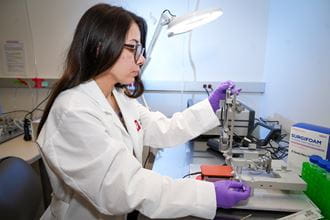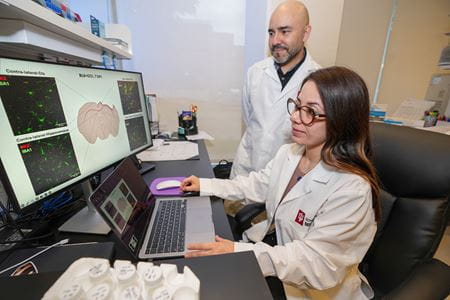Researchers from the Indiana University School of Medicine are investigating why individuals who have experienced traumatic brain injuries — whether from a single or repeated impacts — have nearly two to four times greater the risk of developing Alzheimer’s disease later in life.
The study, led by Claudia Mera-Reina, MD, PhD, postdoctoral fellow, and Juan F. Codocedo, PhD, assistant research professor — both from the Department of Anatomy, Cell Biology, and Physiology at the IU School of Medicine — is exploring chronic inflammation as a potential mechanistic link between traumatic brain injury and Alzheimer’s disease.
According to the U.S. Centers for Disease Control and Prevention, more than 2.5 million people in the United States sustain a traumatic brain injury each year. Nearly one-fifth of those experience a moderate or severe injury, which might occur from serious falls, vehicle crashes or repeated blows to the head from sports.
The effects of this type of injury on the brain can be long-lasting, even if symptoms don’t immediately appear. In many cases, individuals show no signs of cognitive problems following a traumatic brain injury, and changes in the brain can remain silent for years, Mera-Reina said.
One of the brain’s first responses to injury involves the activation of microglia, the primary immune cells in the brain. These cells act as the first line of defense, helping to remove damaged cells and support the brain’s recovery process. This early inflammatory response is beneficial, Mera-Reina said, but if the response continues for too long, it can become harmful.
 “We are investigating the molecular mechanisms that may cause microglia to remain active for too long after a traumatic brain injury,” Mera-Reina said. “Although the exact connection between traumatic brain injury and Alzheimer’s disease isn’t fully understood, both conditions involve a strong inflammatory response in the brain.”
“We are investigating the molecular mechanisms that may cause microglia to remain active for too long after a traumatic brain injury,” Mera-Reina said. “Although the exact connection between traumatic brain injury and Alzheimer’s disease isn’t fully understood, both conditions involve a strong inflammatory response in the brain.”
The IU School of Medicine leads multiple consortia and research programs — resulting in tens of millions of dollars in grant funding — dedicated to investigating traumatic brain injuries as well as Alzheimer's disease and related dementias.
Prolonged microglial activation can lead to chronic inflammation and the continuous release of inflammatory molecules, which can damage neurons over time — a process known as secondary injury, Mera-Reina said. Research shows persistent inflammation may contribute to the development of Alzheimer’s disease. In some individuals with a history of traumatic brain injury, the disease is accompanied by hallmark brain changes such as the buildup of amyloid plaques and tau tangles, which are closely associated with cognitive decline.
“Microglia normally help keep the brain healthy by clearing out waste and damaged material, but in Alzheimer’s disease, this cleanup process doesn’t work as well. We think something similar may happen after a brain injury, which could contribute to the buildup of harmful proteins like amyloid-beta and tau,” Mera-Reina said. “Understanding how and when these changes begin could help identify new windows for intervention before lasting damage occurs.”
Mera-Reina and Codocedo — who both work in the laboratory of Gary Landreth, PhD, at the Stark Neurosciences Research Institute — each received grant funding to support this research. Mera-Reina received a two-year, $159,716 grant from the Alzheimer’s Association’s 2025 International Research Grant Program. Codocedo received a two-year, $159,170 grant from the Indiana Traumatic Spinal Cord and Brain Injury Research Grant Program, funded through the Indiana Department of Health and administered by the Indiana Clinical and Translational Sciences Institute.
 The grant awarded to Codocedo will allow him to use spatial transcriptomics to evaluate gene expression within specific regions of the brain. He will work closely with Adrian Oblak, PhD, associate professor of radiology and imaging sciences and the co-director of the biomarker core at the Stark Neurosciences Research Institute.
The grant awarded to Codocedo will allow him to use spatial transcriptomics to evaluate gene expression within specific regions of the brain. He will work closely with Adrian Oblak, PhD, associate professor of radiology and imaging sciences and the co-director of the biomarker core at the Stark Neurosciences Research Institute.
“We're going to be able to do a series of experiments that is going to allow us to understand what is happening in areas close to the injury and away from the injury,” Codocedo said.
Mera-Reina is leading a longitudinal study of traumatic brain injury in animal models of Alzheimer’s disease. Through the support of the Alzheimer’s Association, Mera-Reina will monitor the progression of Alzheimer’s disease at multiple points after traumatic brain injury using MRI technology in the Roberts Translational Imaging Facility.
Codocedo and Mera-Reina are studying hexokinase 2, a key metabolic enzyme that plays a central role in inflammation driven by activated microglia. In the central nervous system, the enzyme is expressed almost exclusively in microglia, Codocedo said. When these cells become activated, they shift their metabolism to support immune functions like proliferation and cytokine production. In Alzheimer’s disease, hexokinase 2 levels are significantly elevated and can become harmful, fueling chronic inflammation and contributing to neurodegeneration.
“We think that by targeting hexokinase 2, we’ll be able to modulate microglia, reduce harmful inflammation and promote more beneficial immune responses,” Codocedo said. “Our goal is to uncover the underlying mechanisms, but ultimately, we hope to identify a therapeutic strategy that could benefit people living with Alzheimer’s disease and dealing with the long-term effects of a traumatic brain injury.”
The research team is using both pharmacological and genetic approaches to target hexokinase 2 in animal models. The pharmacological strategy involves administering a cancer drug, lonidamine, which has been shown to block microglial inflammation. This allows the team to evaluate the potential therapeutic benefits of inhibiting hexokinase 2 activity. The genetic approach uses partial deletion of hexokinase 2 in the brain to explore its specific role in regulating inflammation and driving disease progression.
By comparing these two strategies, the research team hopes to better understand how hexokinase 2 influences microglial behavior across different stages of disease.
